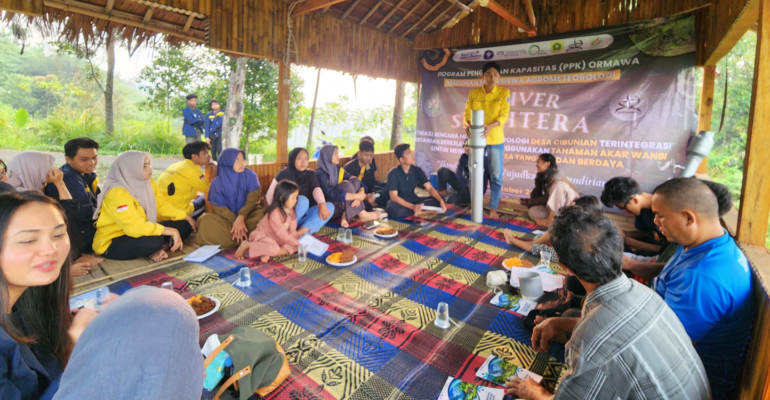Establishing Cibunian Climate Village, PPK Ormawa Himagreto IPB University Builds Collaboration House

The Capacity Building Program for Student Organizations (PPK Ormawa) led by the Geophysics and Meteorology Student Association (Himagreto) of IPB University focuses on community development in Cibunian Village, Pamijahan, Bogor Regency, West Java.
One of the initiatives is the Collaboration House. This program comprises three main components: meteorological instrumentation, biointensification, and agroforestry planting techniques. On Friday (12/7), the PPK Ormawa Himagreto team held a socialization and practical implementation of the Collaboration House program. This event was open to the residents of RW 17, RW 6, and the youth in the area. Several students from Universitas Padjadjaran also participated with a similar agenda.
Muhammad Raihan Mubarok, a representative from Himagreto IPB University, stated that the introduction of meteorological instruments, organic fertilizer production, and vetiver grass planting were fundamental steps in this activity. The goal was to inspire and motivate new economic development ideas within the local community.
“We introduced weather measuring instruments relevant to the climate village program we designed. Additionally, biointensification and agroforestry offer economic development benefits for the community,” he said.
The Collaboration House training leverages the agricultural lifestyle of Cibunian Village to create advanced economic potential for both local communities and industrial sectors. The training was conducted in two locations: discussions in a hut and joint agroforestry planting practice in the field.
In the program’s execution, IPB University students collaborated with Hutan Wakaf Bogor. Hutan Wakaf provided huts and land for meetings and planting practices.
Sahrudin, one of the managers of Hutan Wakaf Bogor, mentioned that the collaborative steps taken by IPB University students were quite intriguing for community economic development. The climate village concept proposed by the students aligns with the climate-friendly program he planned.
“The hope is that this can be the beginning of collaboration that can engage all aspects of the community, from fathers, mothers, and youth to school children,” he said.
The collaboration extends beyond basic introduction and practice, aiming to empower community creativity and economics in line with the climate village goals.
“Through the Collaboration House activities, it is hoped to create a community that is independent, creative, and proactive in climate awareness and economic improvement. With enthusiasm, motivation, and creativity, it is hoped that the collaboration formed in the Collaboration House can maximize benefits for all parties,” Raihan added.
Thus, he said, Cibunian Village can become a climate-responsive village that is always aware of weather conditions and waste management for more optimal harvest results. (*/Rz) (IAAS/RUM)



